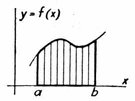
COURSE INFO
SCHEDULE
SYLLABUS
HOMEWORK
WRITING ASSIGNMENTS
OFFICE HOURS
|
Math 126, Spring 2004
Calculus 2
Writing Assignments
Give brief but clear answers to the questions below. Click on this link to send me an email with your answers. Make sure to type 'Calculus Assignment' and the date in the subject line.
For Friday, October 1
Section 7.3: Trig Substitution
- Explain the term 'inverse substitution'. Why is it applicable to this section?
- Review the identities used to determine the table on page 490. From what basic identity do they all emerge?
- How would example 2 on page 491 change if we were asked to find the area of a circle?
For Tuesday October 5
Section 7.4: Integration of Rational Functions by Partial Fractions
- Breaking an integrand into partial fractions 'undoes' what third-grade technique for adding fractions?
- What are the conditions on the degrees of the polynomials in the numerator and denominator when using partial fractions?
- (Tougher) Why are the numerators in Equation 7 (page 499) all constant? (Why does this work?
For Thursday, October 7
Section 7.5-6 Integration Strategies and Integration Tables
- Give a brief synopsis of the type of integrals encountered thus far.
- Explain your own personal strategy for attacking an integral. Write as though you were talking to a student studying for a Calc exam.
- What can we do in class to help you remember this armory of techniques that we have now?
For Friday, October 8
Section 7.7: Approximate Integration
- Which are the two techniques that we have used thus far to estimate definite integrals?
- How does the trapezoid rule come about as an extension of the left-hand and right-hand rules?
- Why would the error bounds for the trapezoid rule be dependent on the second derivative? For Simpson's rule on the fourth derivative?
For Tuesday October 12
Fall Break!!
Go to www.setgame.com to learn how to play my second favorite game. (My first is bridge. Yes, bridge. It's not just for little old ladies anymore!)
For Thursday, October 14
Section 7.8: Improper Integrals and Limits
- How is it possible that the infinite interval on page 530 bounds only a finite area?
- How can we take one of our bounds of integration to be positive infinity?
- Explain the Comparison Theorem (page 506) in words.
For Friday, October 15
Review of Integration
- Look at problems 1, 2, 6, and 11 on pages 544-545. Give a strategy for solving each of these.
- There is an exam in a week!!!! What would be most helpful for you in preparation for the test?
For Tuesday October 19
Section 8.1 & 8.2: Arc Lengths and Surface Area
- How does the formula for Arc Length come about as a consequence of the Pythagorean Theorem?
- How does computing the surface area of an object fit in with our scheme of breaking up larger objects into smaller components?
- Read exercise 25 and explain the 'paradox' that arises if we think of Gabriel's Horn as a paint can.
For Thursday, October 21
Review for Exam 2
You may download a copy of the practice exam here. We will go over this on Thursday. Come prepared with questions that will clear up your confusions about the material. Here is a copy of the solutions to that exam.
For Friday, October 22
Midterm assessment (may be completed any time during the week after the exam. You may answer these questions through campus mail or borrow a friend's email account if you want to keep your answers confidential)
- What is going well in class thus far? What could be going better?
- What am I doing well as a professor thus far? What could I be doing better?
- What are you doing well as a student thus far? What could you be doing better?
For Tuesday October 26
Section 11.1: Introduction to Sequences
- What does it mean for a sequence to approach a limit?
- Give an explanation of how a sequence can have an infinite limit.
- What nice properties do sequences have that limits have? That derivatives and integrals have?
- Comment: The test was easier/about as hard/harder than I expected it would be.
For Thursday, October 28
Section 11.2: Introduction to Series
Note: You'll need to review your notes (or someone else's notes) from Day 1, and refamiliarize yourself with sigma notation.
- How do we get a series from a sequence? How do we get a sequence from a series?
- Explain Theorem 6 (page 718) in words.
- Research Zeno's Paradox, and explain how it fits into a discussion of Geometric Series.
For Friday, October 29
Section 11.3: The Integral Test
- How can we tie the convergence or divergence of a series to the convergence or divergence of an integral?
- How does the harmonic series serve as a 'boundary' between convergent and divergent p-series?
- How can we use the integral test to tell how accurate an estimate we can get on a series sum?
- If you were to dress up as a mathematical concept for Halloween, which integral would you go as and why?
Give brief but clear answers to the questions below. Click on this link to send me an email with your answers. Make sure to type 'Calculus Assignment' and the date in the subject line.
Barry Balof's Home Page
Whitman Math Home
Whitman College Home
|
